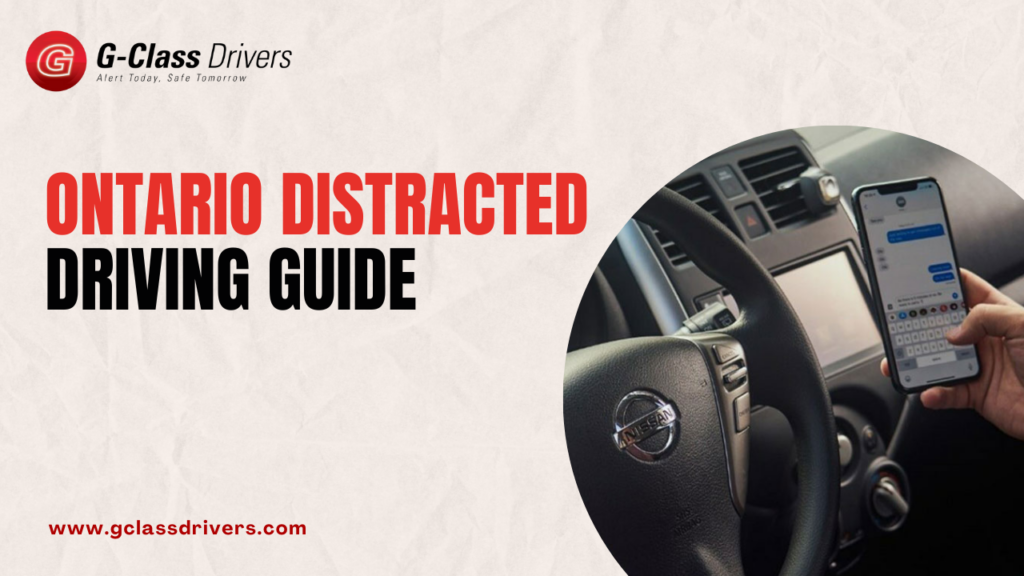Distracted driving in Ontario is a national safety concern that affects everyone in Canada. Driving while talking, texting, typing, dialing, or emailing on a mobile phone or other handheld communication and entertainment device is unlawful in Ontario. According to the Insurance Bureau of Canada (IBC), distracted driving is just as dangerous as drunk driving.
Almost three out of every four Canadians admit to driving while distracted. Legislation is frequently revised, with many regions continuing to impose stiffer fines in an effort to reduce distracted driving.
Statistics of Distracted Driving
Here are some eye opening statistics of distracted driving in Ontario:
- You’re also 23 times more likely to crash if you text and drive.
- According to one study, approximately 80% of incidents involved some driving inattention.
- Every 30 minutes, one person is wounded in a distracted driving collision.
- Distracted driving deaths in Ontario have doubled since 2000.
What is distracted driving in Ontario?
According to the RCMP, distracted driving in Ontario is more than just using your phone while driving. Going while distracted occurs when distractions impair your judgment and prevent you from driving safely.
It is unlawful to do the following while driving, stopped in traffic, or stopped at a red light:
- Use cell phones to text, type, dial, or send emails.
- Use a tablet, laptop, music player, or portable gaming system.
- View unrelated display screens (such as when watching a YouTube video or TikTok).
- Programming a GPS gadget by hand
Inside a vehicle:
Here are some examples of distracted driving in ontario inside the vehicle are given below :
- Using a cell phone (talking, texting, and online browsing)
- GPS Programming
- Examining a map or a book
- Vaping and smoking
- Grooming
- Viewing videos
- Consumption of food and beverages
- Changing the radio station
- Music that is too loud
Outside the vehicle:
While examples of distracted driving in ontario outside the vehicle are given below:
- Cyclists enjoying the scenery
- Other modes of transportation
- Construction
- Motorcycles
- Noise from the street
- Examining advertisements
- Pedestrians
- Accident scene
Driving while distracted can result in punishments like the cancellation of your license and removal from the graduated licensing system.
Distracted Driving Laws In Ontario
As dangerous, distracted driving in Ontario is a criminal offense against the law. It is illegal in Ontario to use handheld communication and electronic entertainment devices while driving. Phones, iPods, iPads, tablets, DVD players, and e-readers are examples.
It is also illegal to drive while holding a phone or other gadget. Devices such as Apple watches and other smartwatches could be deemed distracting in today’s ever-changing and wearable technology age. Distracted driving is illegal across Canada, each province and territory has its legislation, so penalties can vary substantially.
Penalties Of Distracted Driving In Ontario
Distracted driving can result in punishments like the cancellation of your license and removal from the graduated licensing system.
For Fully Licensed Driver
Fully licensed drivers, the following is the punishment criteria in case of distracted driving in Ontario:
- A first conviction carries a $1,000 fine, three demerit points, and a three-day driver’s license suspension.
- A second conviction carries a penalty of up to $2000, 6 demerit points, and a 7-day driver’s license suspension.
- Third and subsequent convictions result in a penalty of up to $3000, 6 demerit points, and a 30-day driver’s license suspension.
For Novice drivers
Suppose you have a G1, G2, M1, or M2 license and are convicted of distracted driving. Then, you will also face the same fines for your license and its removal from the graduated licensing system:
- A first offense carries a $1,000 fine and a 30-day license suspension.
- A second conviction carries a fine of up to $2000 and a 90-day license suspension.
- Third and subsequent offenses result in a fine of up to $3000, the cancellation of your license, and exclusion from the Graduated Licensing System.
Driving Carelessly Or Dangerously
Careless driving or dangerous driving can be considered distracted driving. Being convicted of distracted driving while endangering others could result in even harsher penalties. MTO elaborates:
“Drivers who endanger others because of any distraction, including handheld and hands-free devices, may still be charged with careless driving under the Highway Traffic Act or even dangerous driving under the Criminal Code of Canada.”
If you are convicted of careless driving as a result of distracted driving, you will face the following penalties:
- Six minus points
- Fines of up to $2,000 are possible.
- Six months in jail
- Suspended license for up to two years
- For causing bodily harm, you might face up to ten years in prison.
Ontario Highway Traffic Act & Distracted Driving
The Ontario Highway Traffic Act and Distracted Driving Section 78 states:
- No one shall drive a motor vehicle on a roadway if the driver can see the display screen of a television, computer, or other device in the motor vehicle.
- Handheld gadgets are not permitted.
- No one shall operate a motor vehicle on a highway while holding or using a handheld wireless communication device or any other prescribed device capable of receiving or transmitting telephone communications, electronic data, mail, or text messages.
- Devices for entertainment
- Driving a motor vehicle on a highway while holding or using a portable device is illegal.
Tips to avoid distracted driving
Here are the 9 most important tips to avoid distracted driving and for a safe drive.
- Start by storing your device because you know you won’t be able to use it while driving. Switch it off and place it somewhere out of reach, such as in your glove compartment or trunk.
- Before you start driving, review any maps and directions you have. To avoid distracted driving, “Figuring it along the way” is ineffective. A global positioning system navigation device is an exception, according to Section 78.1 of the Highway Traffic Act. However, programming your GPS while driving is illegal.
- Remove anything unnecessary for your journey and secure any loose objects. Sliding objects can be distracting when turning a bend or braking hard.
- Before you leave, ensure the children have everything they need – reading materials, toys, food, and water. Also, ensure you’re prepared, including having your personal grooming done before getting behind the wheel.
- If you don’t have a box or a car barrier, think about getting a car belt or even a car seat to keep your pet from leaping around in the car.
- Before pulling out of the driveway, ensure your radio presets are selected and your climate control is turned on.
- Actively drive, scan the road, and continue to check your mirrors. Keeping two hands on the steering wheel improves control and reduces fatigue. Don’t let roadside activities, such as a yard sale or a clown holding a sign, distract you.
- As a general guideline, you should take a break from driving every two hours. You can get the required fuel for yourself, your fellow passengers, and your vehicle. The rest and movement will also allow you to re-energize and refocus on the rest of your journey.
- While an open coffee or drink in a cup holder shouldn’t be a major distraction, don’t eat or drink anything that requires you to open, unwrap, or otherwise distract you.
Conclusion
Distracted driving in Ontario threatens road safety, with alarming statistics. Strict laws and penalties are in place to combat this dangerous behavior, which goes beyond legislation. It requires a collective commitment from all drivers to recognize safety measures. Minimizing distractions within vehicles and adopting safe driving practices are crucial steps. Prioritizing safety over momentary distractions is important for making our roads safer. Road safety is a shared responsibility, and ending distracted driving is a significant step towards this goal.





